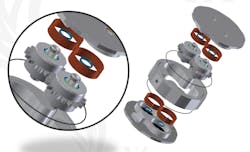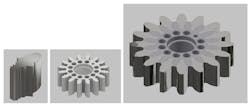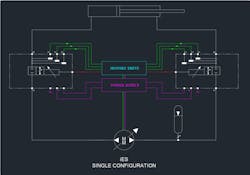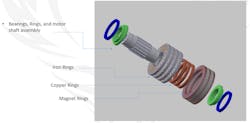Electrohydraulic System Improves Efficiency Through Use of Drive-Drive Design
*Editor's Note: This article was originally published in August 2022 and updated in March 2023 with new information.
After 8 years of development, DriveDrive Power (formerly known as Project Phoenix LLC) is ready to bring its Independent Electrohydraulic System (IES) to the market. IES is an intelligent electrohydraulic solution designed to replace traditional hydraulic control systems.
In essence, it is a servo-driven, drive-drive hydraulic gear pump with integrated electronics and software which is designed to provide a 15x improvement upon traditional hydraulic systems currently available in the market.
The IES is comprised of the following components:
- one e-pump,
- two e-valves,
- one e-accumulator,
- a motion control package,
- a power supply, and
- one Energy Regeneration and Storage Unit (ERSU).
The system is compactly designed with the majority of the components installed within the pump housing which provides mounting flexibility.
It features “fly-by-wire” control technology which means everything is electronically controlled explained Tom Afshari, Chief Design Engineer at DriveDrive Power, in an interview with Power & Motion. There is no hydraulic line feedback, everything is controlled by electronic signals. “The hydraulics are completely segregated from the control loop which is 100% electric,” he said.
This enables high-performance responses within the system as well as built-in redundancy to optimize operation.
New Motor Design Improves Precision and Efficiency
According to Afshari, the IES came about after the company invested in transverse flux motor technology. This high torque motor type provides high power at low rpms, typically around 900 rpm. He noted it is also a reverse motor in which the stator is the core of the motor and the rotor is on the outside diameter.
While working with the transverse flux motor, Afshari said he began thinking about how it could be utilized in the field of hydraulics. During his years of working in the hydraulics industry he heard from people that hydraulics is powerful but not precise. But he knew the industry could do better to improve the precision of hydraulics; once he saw the capabilities of the transverse flux motor Afshari said he knew that was the solution.
The IES features two of these high-torque motors integrated inside the e-pump casing, and their rotating outside diameter is what creates displacement said Afshari. The e-pump is described by DriveDrive Power as a positive-displacement external gear pump. It is a drive-drive hydraulic pump powered by the integrated motors which are directly connected to spur gears.
Afshari said this design enables a transition from fluid power to motion control. New software algorithms were developed and work in tandem with the motors to provide more precise control of gear teeth movement.
Using these algorithms allows the synchronization of the motor and gear movements to ensure consistent pump efficiency. Afshari explained that in a traditional system one motor-gear combination essentially runs the other and as pressure goes up, the main motor pushes the other so hard that wear and tear begins to occur, as well as other potential issues. But by going to a drive-drive system instead like the one utilized by the IES, that push of one motor-gear unit on another is eliminated and the motors equally contribute to the creation of displacement.
The motors are synchronized at about 5 Nm. If they go below this force level due to contamination, viscosity drop, or another issue the pump automatically indexes itself to return to an appropriate working force said Afshari.
There are many efficiency gains which can be achieved with the IES. Its slip coefficient, for instance, is under 5% equating to 90-95% hydraulic efficiency at the pump he said. While pressure drops or other phenomenon are common with pumps used in the field, “port to port you have a significant improvement in efficiency,” said Afshari. “Mechanical losses are put back in the system as energy savings due to the gear systems not rubbing or pushing each other [but instead being] independently driven.”
Redundancy is another benefit offered by the chosen motor design. If something happens to one of the motors, the other can continue running the pump for a limited time which helps to reduce unplanned downtime.
READ MORE: The Continued Evolution of Hydraulics and Pneumatics
Built-In Intelligence Benefits Performance and Maintenance
Electronics built into the IES—including pressure, flow and temperature sensors—as well as the software algorithms developed by DriveDrive Power help to provide improved control of the system and its various components.
“That creates this very clean, very simple loop of information cycling through the system, and keeps giving the motion controller which runs the pump enough information to make determinations on how adjustments need to be made,” said Afshari.
He explained that it is a closed loop communication system in which substantial amounts of information and data are being shared both within the IES and with other machine systems. This provides improved performance and maintenance capabilities. For instance, during testing the company found it could more accurately move hydraulic cylinders using the IES because of its built-in electronics and algorithms. And it can do so in a smoother manner than traditional hydraulic pump systems would.
This is possible because of the ability to control the pressurized fluid coming out of the pump, said Afshari. “We measure and know the flow, viscosity, pressure, and temperature; everything is calculated and based on that can determine the appropriate displacement to move the cylinder.”
Multiple IES can be used in series or parallel as well. Doing so is an easier set up for design teams because the pump is able to automatically determine if something is not configured or working as it should whereas with a traditional hydraulic system when it is set up incorrectly catastrophic failures can occur.
The IES, on the other hand, is able to provide an alarm and let users know what the issue is—such as pressure dropping on one pump but increasing on another which alerts them to the fact the ports are wrong. “It is very easy to determine what you are doing right or wrong because of the amount of data built into the system,” said Afshari.
He noted the majority of the alarms the DriveDrive Power team has seen with the system are from cavitations, wear and contamination. “The system is very sensitive. If suddenly there is a shaved metal piece which enters between the gears, an alarm goes out that something is out of balance.”
One of the pumps the company has been testing has 6,000 hours on it and there are no marks on the gears, said Afshari. But if you were to look at a traditional hydraulic pump after 6,000 hours it would be a different story.
The pump’s ability to improve precision and alert users the moment an issue is detected helps to reduce wear, and thus maintenance. How much lower maintenance will be is yet to be determined because the pump will need to be run 200,000-300,000 hours based on the work done so far. “6,000 hours would be just right for a traditional hydraulic system to measure the wear,” explained Ashfari. “We cannot measure anywhere within this timeframe right now.”
He said the pump housing will always have wear because it is usually made from a softer metal, but the core of it will remain intact.
In addition to the intelligence built into the IES, it can collect data as well throughout its operating life building up further performance metrics. With this information users can be more proactive with their maintenance. Should there be a potential issue, Afshari said users can look up the collected data to determine what is happening without having to stop the working machine to do so. This helps to minimize downtime, particularly in critical applications such as military or autonomous vehicles.
A Variety of Applications and Use Cases
Afshari said the IES can be used in applications where direct-drive hydraulic or other fluid driven systems are typically used—everything from prosthetics to the brakes in a car to the flight control system of a space shuttle.
As an example, he noted the benefit of using the IES for leveling systems whether in a car, ambulance or other application. Today, these use hydraulics but if a leak occurs the system can lose its balance. The IES, however, is constantly adjusting itself to ensure it is performing correctly so even if a leak were to occur the leveling system would remain balanced said Afshari.
The IES could also be beneficial for use in electric-powered applications as it can easily be plugged into a vehicle or machine’s electronics system. It can also be used as an on-board generator as it is capable of collecting and reusing energy.
Afshari noted the use of two electric motors benefits use in electric vehicle applications, as well. “It is very difficult to power up the hydraulics with a 100 hp electric motor as it requires a lot of initial amperage. But it is very easy to power up two motors slowly” which enables the on-board generator to be right sized for the application he explained.
DriveDrive Power debuted the IES during the International Fluid Power Exposition (IFPE) 2023. Afshari said the system is at the development stage where it is ready for production and use in various applications. The goal is to partner with hydraulics companies and pair the IES with products such as hydraulic power units or cylinders to bring increased intelligence and precision to the industry.
About the Author
Sara Jensen
Executive Editor, Power & Motion
Sara Jensen is executive editor of Power & Motion, directing expanded coverage into the modern fluid power space, as well as mechatronic and smart technologies. She has over 15 years of publishing experience. Prior to Power & Motion she spent 11 years with a trade publication for engineers of heavy-duty equipment, the last 3 of which were as the editor and brand lead. Over the course of her time in the B2B industry, Sara has gained an extensive knowledge of various heavy-duty equipment industries — including construction, agriculture, mining and on-road trucks —along with the systems and market trends which impact them such as fluid power and electronic motion control technologies.
You can follow Sara and Power & Motion via the following social media handles:
X (formerly Twitter): @TechnlgyEditor and @PowerMotionTech
LinkedIn: @SaraJensen and @Power&Motion
Facebook: @PowerMotionTech

Leaders relevant to this article:





